| |||
|---|---|---|---|
| +... |
| Years in film |
|---|
 |
| 19th century |
| 1870s |
The following is an overview of the events of 1888 in film, including a list of films released and notable births.
| |||
|---|---|---|---|
| +... |
| Years in film |
|---|
 |
| 19th century |
| 1870s |
The following is an overview of the events of 1888 in film, including a list of films released and notable births.
| Month | Date | Name | Country | Profession | Died | |
| January | 3 | George B. Seitz | US | Director, writer, actor, producer | 1944 | |
| 3 | James Bridie | Scotland | Writer | 1951 | ||
| 17 | Edvard Persson | Sweden | Actor | 1957 | ||
| February | 6 | Lucile Gleason | US | Actress | 1947 | |
| March | 4 | Rafaela Ottiano | Italy | Actress | 1942 | |
| 5 | Jules Furthman | US | Writer, director, producer | 1966 | ||
| 10 | Barry Fitzgerald | Ireland | Actor | 1961 | ||
| 30 | Anna Q. Nilsson | Sweden | Actress | 1974 | ||
| April | 11 | Donald Calthrop | UK | Actor | 1940 | |
| 15 | Florence Bates | US | Actress | 1954 | ||
| 19 | Pat West | US | Actor | 1944 | ||
| 27 | Florence La Badie | US | Actress | 1917 | ||
| May | 7 | Selmer Jackson | US | Actor | 1971 | |
| 17 | Claude Mérelle | France | Actress | 1976 | ||
| 25 | Miles Malleson | UK | Actor, Writer | 1969 | ||
| July | 4 | Henry Armetta | Italy | Actor | 1945 | |
| 16 | Percy Kilbride | US | Actor | 1964 | ||
| August | 14 | Robert Woolsey | US | Actor | 1938 | |
| 17 | Monty Woolley | US | Actor | 1963 | ||
| 29 | Dina Romano | Italy | Actress | 1957 | ||
| September | 12 | Maurice Chevalier | France | Actor, Singer | 1972 | |
| 25 | Hanna Ralph | Germany | Actress | 1978 | ||
| 26 | Wally Patch | UK | Actor, writer | 1970 | ||
| October | 1 | John E. Blakeley | UK | Producer, director, writer | 1958 | |
| 3 | Claud Allister | UK | Actor | 1970 | ||
| 9 | Hank Patterson | US | Actor | 1975 | ||
| 18 | Paul Vermoyal | France | Actor | 1925 | ||
| 25 | Lester Cuneo | US | Actor, producer | 1925 | ||
| November | 3 | Maurice Vinot | France | Actor | 1916 | |
| 15 | Andreas Malandrinos | Greece | Actor | 1970 | ||
| 18 | Frances Marion | US | Writer, director, producer, actress | 1973 | ||
| 23 | Nana Bryant | US | Actress | 1955 | ||
| 23 | Harpo Marx | US | Actor, writer | 1964 | ||
| 24 | Cathleen Nesbitt | UK | Actress | 1982 | ||
| 25 | Amund Rydland | Norway | Actor | 1967 | ||
| 26 | Francisco Canaro | Uruguay | Composer, Producer, Actor | 1964 | ||
| December | 6 | Will Hay | UK | Actor, writer, director | 1949 | |
| 18 | Gladys Cooper | UK | Actress | 1971 | ||
| 22 | J. Arthur Rank | UK | Producer, writer | 1972 | ||
| 27 | Thea von Harbou | Germany | Actress, writer, director | 1954 | ||
| 27 | Svend Melsing | Denmark | Actor, Playwright | 1946 | ||
| 28 | F. W. Murnau | Germany | Director, writer, producer | 1931 | ||

The Lumière brothers, Auguste Marie Louis Nicolas Lumière and Louis Jean Lumière, were French manufacturers of photography equipment, best known for their Cinématographe motion picture system and the short films they produced between 1895 and 1905, which places them among the earliest filmmakers.
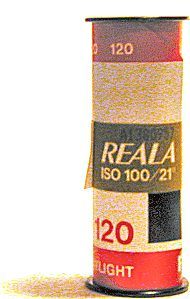
Roll film or rollfilm is any type of spool-wound photographic film protected from white light exposure by a paper backing. The term originated in contrast to sheet film. Confusingly, roll film was originally often referred to as "cartridge" film because of its resemblance to a shotgun cartridge.
A movie camera is a type of photographic camera that rapidly takes a sequence of photographs, either onto film stock or an image sensor, in order to produce a moving image to display on a screen. In contrast to the still camera, which captures a single image at a time, the movie camera takes a series of images by way of an intermittent mechanism or by electronic means; each image is a frame of film or video. The frames are projected through a movie projector or a video projector at a specific frame rate to show the moving picture. When projected at a high enough frame rate, the persistence of vision allows the eyes and brain of the viewer to merge the separate frames into a continuous moving picture.

Emile Berliner originally Emil Berliner, was a German-American inventor. He is best known for inventing the lateral-cut flat disc record used with a gramophone. He founded the United States Gramophone Company in 1894.
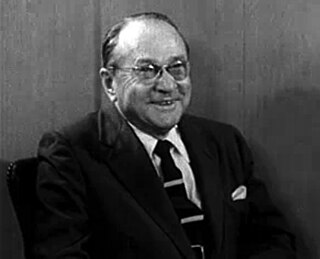
Vladimir Kosma Zworykin was a Russian-American inventor, engineer, and pioneer of television technology. Zworykin invented a television transmitting and receiving system employing cathode-ray tubes. He played a role in the practical development of television from the early thirties, including charge storage-type tubes, infrared image tubes and the electron microscope.

Louis Aimé Augustin Le Prince was a French artist and the inventor of an early motion-picture camera, and director of Roundhay Garden Scene.
The year 1888 in science and technology involved some significant events, listed below.

Roundhay Garden Scene is a short silent motion picture filmed by French inventor Louis Le Prince at Oakwood Grange in Roundhay, Leeds, in Yorkshire on 14 October 1888. It is believed to be the oldest surviving film. The camera used was patented in the United Kingdom on 16 November 1888.

Ottomar Anschütz was a German inventor, photographer, and chronophotographer.
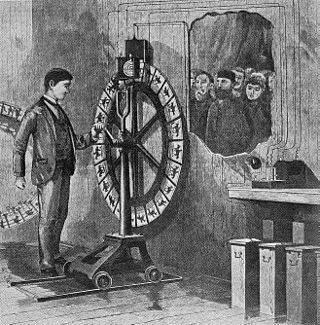
The Elektrische Schnellseher or Electrotachyscope was an early motion picture system developed by chronophotographer Ottomar Anschütz between 1886 and 1894. He made at least seven different versions of the machine, including a projector, a peep-box viewer and several versions with illuminated glass photographs on a rotating wheel viewed on a 12.5 cm (4.9 in) wide milk glass screen by up to seven people at the same time.

Chronophotography is a photographic technique from the Victorian era which captures a number of phases of movements. The best known chronophotography works were mostly intended for the scientific study of locomotion, to discover practical information for animal handlers and/or as reference material for artists. Although many results were not intended to be exhibited as moving pictures, there is much overlap with the more or less simultaneous quest to register and exhibit photographic motion pictures.

Precursors of film are concepts and devices that have much in common with the later art and techniques of cinema.

The Benz Patent-Motorwagen, built in 1885 by the German engineer Karl Benz, is widely regarded as the first practical modern automobile and was the first car put into production. It was patented in January 1886 and unveiled in public later that year. The original cost of the vehicle was 600 imperial German marks, approximately 150 US dollars.
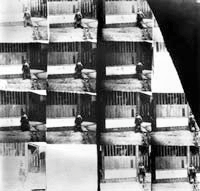
The year 1887 in film involved some significant events.
The decade of the 1880s in film involved significant events.

Sir Robert Abbott Hadfield, 1st Baronet FRS was an English metallurgist, noted for his 1882 discovery of manganese steel, one of the first steel alloys. He also invented silicon steel, initially for mechanical properties which have made the alloy a material of choice for springs and some fine blades, though it has also become important in electrical applications for its magnetic behaviour.
Leisurely Pedestrians, Open Topped Buses and Hansom Cabs with Trotting Horses is a 1889 British short silent actuality film, shot by inventor and film pioneer William Friese-Greene. The film depicts life at Hyde Park Corner in London. Hyde Park Corner is claimed to be the first film set in London, as well as the first to be filmed on celluloid, although Louis Le Prince successfully shot on glass plate before 18 August 1887, and on paper negative in October 1888. It may nonetheless be the first moving picture film on celluloid and the first shot in London. It was shown mainly to several photographic journalists who saw it during their lifetime—including Thomas Bedding, J. Hay Taylor and Theodore Brown. It is now considered a lost film with only 6 possible frames surviving today.

A film, also known as a movie or motion picture, is a work of visual art that simulates experiences and otherwise communicates ideas, stories, perceptions, emotions, or atmosphere through the use of moving images that are generally, since the 1930s, synchronized with sound and other sensory stimulations. The word "cinema" is borrowed from the French cinéma, an abbreviation of cinématographe, from Ancient Greek meaning "recording movement". The word is today usually used to refer to either a purpose-built venue for screening films, known as a movie theater in the US; the film industry; the overall art form of specifically just filmmaking.
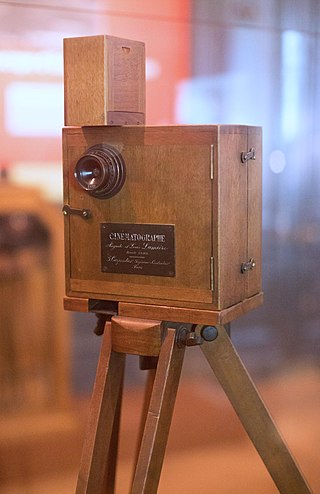
The history of film technology traces the development of techniques for the recording, construction and presentation of motion pictures. When the film medium came about in the 19th century, there already was a centuries old tradition of screening moving images through shadow play and the magic lantern that were very popular with audiences in many parts of the world. Especially the magic lantern influenced much of the projection technology, exhibition practices and cultural implementation of film. Between 1825 and 1840, the relevant technologies of stroboscopic animation, photography and stereoscopy were introduced. For much of the rest of the century, many engineers and inventors tried to combine all these new technologies and the much older technique of projection to create a complete illusion or a complete documentation of reality. Colour photography was usually included in these ambitions and the introduction of the phonograph in 1877 seemed to promise the addition of synchronized sound recordings. Between 1887 and 1894, the first successful short cinematographic presentations were established. The biggest popular breakthrough of the technology came in 1895 with the first projected movies that lasted longer than 10 seconds. During the first years after this breakthrough, most motion pictures lasted about 50 seconds, lacked synchronized sound and natural colour, and were mainly exhibited as novelty attractions. In the first decades of the 20th century, movies grew much longer and the medium quickly developed into one of the most important tools of communication and entertainment. The breakthrough of synchronized sound occurred at the end of the 1920s and that of full color motion picture film in the 1930s. By the start of the 21st century, physical film stock was being replaced with digital film technologies at both ends of the production chain by digital image sensors and projectors.
![]() Media related to 1888 in film at Wikimedia Commons
Media related to 1888 in film at Wikimedia Commons